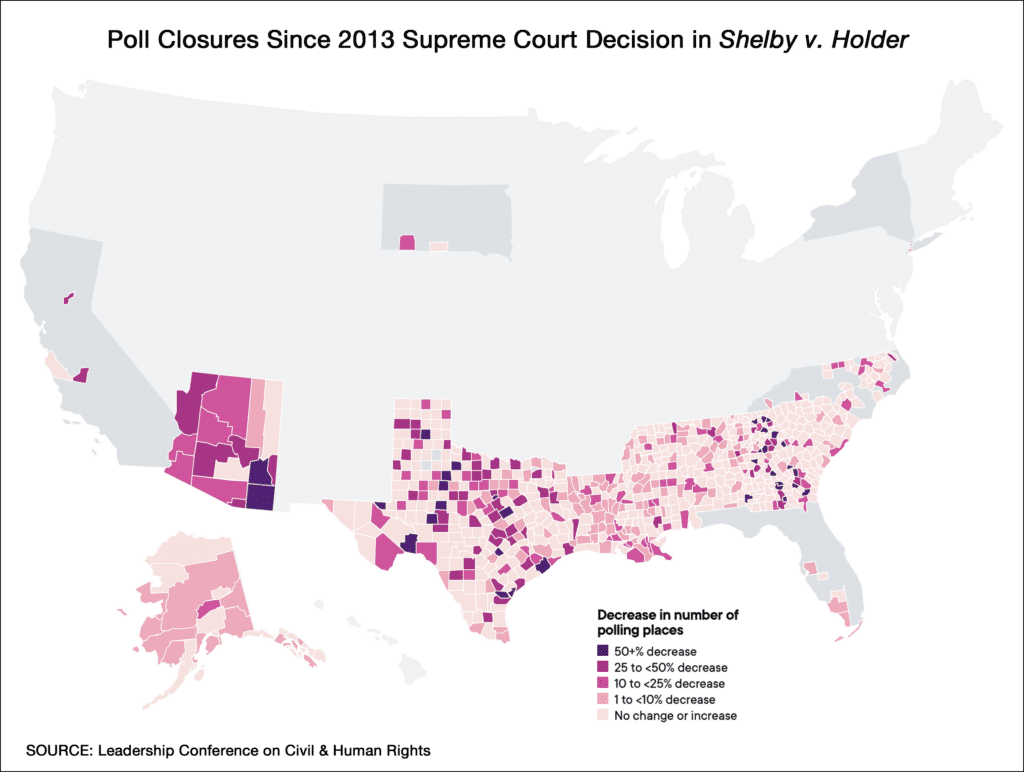
Businesses large (Walmart) and small (Asheville Botanicals) have joined Time to Vote, a national movement within the business community that pledges to give employees time off to vote in elections or otherwise make it easier for their staff to cast their ballots.
The Time to Vote campaign could be more important than ever in 2020 because of the COVID-19 pandemic and its attendant uncertainty. Unlike salaried employees who may be eligible for paid time off, part-time and hourly workers may lose pay and even risk employer retaliation if they take time off work to vote. Businesses that give their workers the day off or that provide resources for early and mail-in voting relieve this stress and encourage more voter participation.
Due to the coronavirus, it is likely that there will be fewer polling stations and longer lines at those that remain open, meaning voters will have a longer wait in line. Volunteers who staff polling stations are often civic-minded senior citizens who have the time to help. This year, Americans over 60 have been warned to stay home because they are at a higher risk of contracting the COVID-19 virus.
With current anxiety about the nature and spread of the virus, and CDC guidance for social distancing, people in many states are debating election delays and the promotion of expanded absentee voting as both primary and general elections approach. For example, despite efforts in Wisconsin by the governor and Democratic lawmakers to delay elections in the state and promote vote by mail in order to protect both poll workers and voters, the legislature insisted on moving forward with in-person voting on April 7. In Milwaukee, fear of exposure caused thousands of poll workers to decline to work, forcing the number of polling centers in the city to be reduced from 180 to five. Many local officials as well as Wisconsin citizens had also been asking for a postponement, Politico reported.
It is also likely that election officials in other states will be forced to reduce the number of polling stations, exacerbating an ongoing problem in some districts, particularly in the South. States in the South have closed nearly 1,200 polling places since the 2013 Supreme Court decision that weakened the Voting Rights Act, a law that was designed to limit voter suppression. In Texas alone, a state where 39% of the population is Latino and 12% is African American, 750 polling places have been shut down since the Court ruling, according to a report by the Leadership Conference on Human and Civil Rights.

If more polling stations disappear because of the pandemic, it may be more difficult for those with lower incomes to access those that remain. And with fewer polling stations, lines will become longer and having the time to vote without fear of losing income will be even more critical.
As Time to Vote notes, providing time off work would help spread voting times throughout the day and reduce congestion in the hours before and after work.
With all of these forces putting pressure on in-person voting, Time to Vote businesses and nonpartisan groups are working to bring alternatives to in-person voting before elections in 2020. One of Time to Vote’s stated options is for businesses to provide “resources for mail-in ballots and early voting”.
Are you a business owner or executive? Do you believe that your workers shouldn’t have to choose between earning a paycheck and voting? Then join the movement.
Many state and local governments already implement mail-in voting. According to the National Conference on State Legislatures (NCSL), Colorado, Hawaii, Oregon, Washington, and Utah mail ballots to all voters, though they retain the option of in-person voting as well. In some states, individual counties have adopted all-mail voting. The NCSL says that potential advantages to voting by mail include voter convenience, higher turnout, and financial savings. A study by the Pew Research Center found that in 2014, Colorado saved $6 per voter per election by reducing expensive polling operations, and other districts have reported $2-5 savings.
The move to mail-in voting for all voters in Colorado in 2014 increased overall participation between 2012 and 2014. Pantheon Analytics showed “a 3.3 percentage point overall increase in turnout due to the move to mailed-out ballots, after adjusting for all other variables.”
According to researchers, however, mail-in ballot laws “don’t end up having a huge impact on voter turnout,” said Seth Masket, a political scientist at the University of Denver, in an interview with the Denver Post. “They make voting a little easier, largely for people who were going to vote anyway.”
While there’s not a noticeable impact in presidential election years, Choate said, mail ballots can boost turnout in lesser known elections. If people receive ballots for elections they may have forgotten about or didn’t know were coming, a mailed ballot makes voters more likely to cast a ballot.
The percentage of mail-in votes to total votes in Colorado has grown over time. According to a Common Cause/Vote at Home report, vote-by-mail (or vote-at-home) provisions have steadily grown in popularity between 2006 and 2012. “In 2006, 39% of voters used vote-by-mail; in 2008, 64% did; in 2010, 67% did, and in 2012, 72% did,” the report noted.
The pandemic has spurred delays in many spring elections and further support for mailed or at-home voting, evident in relaxed rules around absentee voter eligibility. For example, Georgia, Maryland, and Ohio have all postponed their primaries this year. Ohio sends absentee ballot request forms to all 8 million voters for some elections, according to Vote at Home. Georgia and Maryland are no-excuse states, in which voters can ask for a ballot without giving any excuse but must request ballots for elections.
Vote at Home lists several states that are expanding mail-in voting:
- California, which is aiming for 100 % mail-in by 2022 or 2024 elections
- Nebraska, in which 11 out of 93 total counties are 100% mail-in voting for 2020
- New York, which is transitioning to a no-excuse state
- North Dakota, in which 30 out of 53 counties are now 100% mail-in voting.
In general, however, Republicans do not support all-mail voting or increased absentee voting. In Wisconsin, the Republican-controlled legislature chose to press ahead with the April 7 elections despite the health crisis, and they opposed efforts to protect voters and poll workers. And President Trump has vigorously protested mail-in voting. “It shouldn’t be mail-in voting. It should be you go to a booth and you proudly display yourself,” Trump said on April 4, according to the Associated Press. He also said on Fox News Channel’s Fox & Friends “that if you ever agreed to it you’d never have a Republican elected in this country again.”
Ellen Kurz, founder and board president of iVote, noted on Twitter, “This morning on live television, the president of the United States admitted he is opposed to laws that would make it easier for Americans to vote because that would hurt Republicans.” iVote was formed in 2014 to secure equal voting rights for all Americans.
Time to Vote is not just beneficial because it makes it easier for some people to vote in this crisis moment. It also marks a significant culture change as reflected in one of its core principles: “businesses have a responsibility to their people and their community.”
“When the business community comes together to take a stand on issues that affect all Americans, it sends a powerful message,” said Michael Waldman, president of the Brennan Center for Justice, a nonpartisan law and policy institute that supports American democracy. “Ultimately, a culture shift will meaningfully boost voter participation, and business leaders can help drive that shift.”
While the general election is still set for Nov. 3, the uncertainties posed by the coronavirus may ultimately upset election plans. Whatever the day brings, this year’s elections are seeing an unprecedented challenge to our most basic democratic right.
Sources
Time to Vote, “Hundreds of Companies Join Forces, Make Time for Workers to Vote in 2020 Election”, Feb 19, 2020, https://www.maketimetovote.org/pages/press-release, accessed Mar 30, 2020
Time to Vote, “Our Principles”, website homepage, https://www.maketimetovote.org/, accessed homepage on Mar 29, 2020
Jess Bravin and Alexa Corse, “Supreme Court to Weigh In on Wisconsin’s Absentee Ballots”, Wall Street Journal, Apr 5, 2020, https://www.wsj.com/articles/supreme-court-to-weigh-in-on-wisconsins-absentee-ballots-11586118600, accessed Apr 6, 2020
Scott Bauer, Steve Peoples, “Wisconsin moves forward with election despite virus concerns”, Associated Press, appearing in Star Tribune, Apr 6, 2020, https://www.startribune.com/wisconsin-governor-orders-delay-of-election-until-june/569407122/, accessed Apr 7, 2020
Natasha Korecki and Zach Montellaro, “Wisconsin primary to go forward Tuesday even as coronavirus all but shutters the U.S.”, Politico.com, Apr 4, 2020, https://www.politico.com/news/2020/04/04/wisconsin-republicans-reject-tuesday-primary-delay-164911, accessed Apr 4, 2020
Leadership Conference on Civil & Human Rights, “Democracy Diverted: Polling Place Closures and the Right to Vote”, (undated post), http://www.democracydiverted.org, accessed Apr 5, 2020
National Conference of State Legislatures, “All-Mail Elections (AKA Vote by Mail), 2020, https://www.ncsl.org/research/elections-and-campaigns/all-mail-elections.aspx, accessed Apr 5, 2020
Pew Charitable Trusts, “Colorado Voting Reforms: Early Results”, Mar 2016, https://www.pewtrusts.org/~/media/assets/2016/03/coloradovotingreformsearlyresults.pdf, accessed Apr 9, 2020
National Vote at Home Institute, “Vote at Home’ (brochure) Winter 2019-2020 https://www.voteathome.org/wp-content/uploads/2019/08/VAH-intro-flyer.pdf accessed Apr 4, 2020
Allegra Chapman, Amber McReynolds, Tierra Bradford, Kiyana Asemanfar, Elena Nunez, and Gerry Langeler, “The Colorado Voting Experience: A Model that Encourages Full Participation”, Vote at Home and Common Cause, 2019, https://www.voteathome.org/wp-content/uploads/2019/07/ColoradoVotingReport_WEB2.pdf, accessed Apr 9, 2020
Brian Eason, “Colorado crushes national voter turnout figures, but mail ballots aren’t a huge factor, Denver Post, Nov 20, 2016, https://www.denverpost.com/2016/11/20/turnout-flat-colorado-election-2016-mail-ballot-laws, accessed Apr 9, 2020
Associated Press, appearing in MarketWatch, “Trump, Republicans resist calls for widespread use of mail-in ballots as coronavirus pandemic persists”, Apr 5, 2020, https://www.marketwatch.com/story/trump-republicans-resist-calls-for-widespread-use-of-mail-in-ballots-as-coronavirus-pandemic-persists-2020-04-05, accessed Apr 6, 2020
Twitter, @Ellen Kurz, Mar 30, 2020, https://twitter.com/EllenKurz/status/1244685493603913731, accessed Apr 5, 2020
Have a Suggestion?
Know a leader? Progress story? Cool tool? Want us to cover a new problem?

